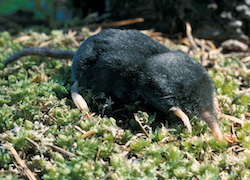American shrew mole
American Shrew Mole (Neurotrichus gibbsii), the smallest mole species in North America, is a unique mammal that belongs to the family Talpidae. It is the only species in the genus Neurotrichus and is characterized by its shrew-like appearance and behaviors, distinguishing it from other mole species. This article provides an overview of the American Shrew Mole, including its habitat, behavior, diet, and conservation status.
Habitat[edit | edit source]
The American Shrew Mole is found primarily in the western parts of North America, ranging from northern California to the southern parts of British Columbia, Canada. It prefers moist, forested areas with abundant leaf litter and underbrush, which provide cover and feeding grounds. Unlike other moles, the American Shrew Mole is less dependent on digging extensive tunnel systems and can often be found foraging on the forest floor.
Behavior[edit | edit source]
This mole is known for its solitary and elusive nature. It is primarily nocturnal, although it may be active during the day in cloudy or rainy weather. The American Shrew Mole digs shallow tunnels and uses surface runways created by other small mammals. It is an adept climber and swimmer, which is unusual for a mole.
Diet[edit | edit source]
The diet of the American Shrew Mole consists mainly of invertebrates, including insects, worms, and slugs. It uses its keen sense of smell to locate prey. The mole's small size and shrew-like teeth allow it to exploit a niche different from that of other mole species, focusing on smaller prey items.
Reproduction[edit | edit source]
Little is known about the reproduction of the American Shrew Mole. It is believed to breed once a year, with a gestation period lasting approximately one month. The litter size ranges from two to four young. The young are born blind and hairless, becoming independent after about one month.
Conservation Status[edit | edit source]
The American Shrew Mole is currently listed as Least Concern by the International Union for Conservation of Nature (IUCN). It is relatively widespread and common within its range. However, habitat destruction and fragmentation could pose future threats to its populations.
Conclusion[edit | edit source]
The American Shrew Mole is a fascinating creature that plays a vital role in the ecosystem by controlling insect populations. Despite its widespread distribution, much remains to be learned about its behavior, ecology, and reproduction. Conservation efforts are essential to ensure that this unique species continues to thrive in its natural habitat.
Search WikiMD
Ad.Tired of being Overweight? Try W8MD's NYC physician weight loss.
Semaglutide (Ozempic / Wegovy and Tirzepatide (Mounjaro / Zepbound) available. Call 718 946 5500.
Advertise on WikiMD
|
WikiMD's Wellness Encyclopedia |
| Let Food Be Thy Medicine Medicine Thy Food - Hippocrates |
Translate this page: - East Asian
中文,
日本,
한국어,
South Asian
हिन्दी,
தமிழ்,
తెలుగు,
Urdu,
ಕನ್ನಡ,
Southeast Asian
Indonesian,
Vietnamese,
Thai,
မြန်မာဘာသာ,
বাংলা
European
español,
Deutsch,
français,
Greek,
português do Brasil,
polski,
română,
русский,
Nederlands,
norsk,
svenska,
suomi,
Italian
Middle Eastern & African
عربى,
Turkish,
Persian,
Hebrew,
Afrikaans,
isiZulu,
Kiswahili,
Other
Bulgarian,
Hungarian,
Czech,
Swedish,
മലയാളം,
मराठी,
ਪੰਜਾਬੀ,
ગુજરાતી,
Portuguese,
Ukrainian
Medical Disclaimer: WikiMD is not a substitute for professional medical advice. The information on WikiMD is provided as an information resource only, may be incorrect, outdated or misleading, and is not to be used or relied on for any diagnostic or treatment purposes. Please consult your health care provider before making any healthcare decisions or for guidance about a specific medical condition. WikiMD expressly disclaims responsibility, and shall have no liability, for any damages, loss, injury, or liability whatsoever suffered as a result of your reliance on the information contained in this site. By visiting this site you agree to the foregoing terms and conditions, which may from time to time be changed or supplemented by WikiMD. If you do not agree to the foregoing terms and conditions, you should not enter or use this site. See full disclaimer.
Credits:Most images are courtesy of Wikimedia commons, and templates, categories Wikipedia, licensed under CC BY SA or similar.
Contributors: Prab R. Tumpati, MD

